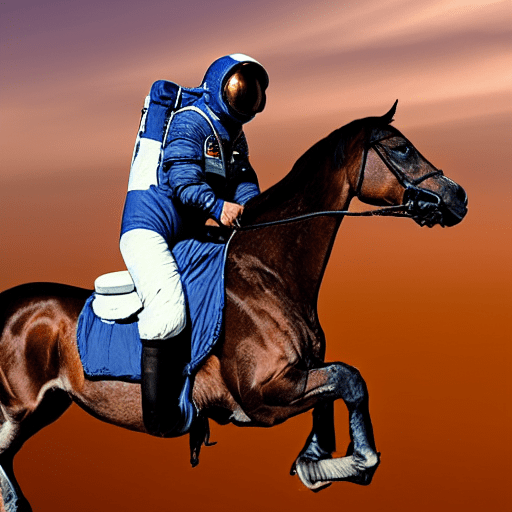# 파이프라인, 모델 및 스케줄러 이해하기
[[open-in-colab]]
🧨 Diffusers는 사용자 친화적이며 유연한 도구 상자로, 사용사례에 맞게 diffusion 시스템을 구축 할 수 있도록 설계되었습니다. 이 도구 상자의 핵심은 모델과 스케줄러입니다. [`DiffusionPipeline`]은 편의를 위해 이러한 구성 요소를 번들로 제공하지만, 파이프라인을 분리하고 모델과 스케줄러를 개별적으로 사용해 새로운 diffusion 시스템을 만들 수도 있습니다.
이 튜토리얼에서는 기본 파이프라인부터 시작해 Stable Diffusion 파이프라인까지 진행하며 모델과 스케줄러를 사용해 추론을 위한 diffusion 시스템을 조립하는 방법을 배웁니다.
## 기본 파이프라인 해체하기
파이프라인은 추론을 위해 모델을 실행하는 빠르고 쉬운 방법으로, 이미지를 생성하는 데 코드가 4줄 이상 필요하지 않습니다:
```py
>>> from diffusers import DDPMPipeline
>>> ddpm = DDPMPipeline.from_pretrained("google/ddpm-cat-256").to("cuda")
>>> image = ddpm(num_inference_steps=25).images[0]
>>> image
```
정말 쉽습니다. 그런데 파이프라인은 어떻게 이렇게 할 수 있었을까요? 파이프라인을 세분화하여 내부에서 어떤 일이 일어나고 있는지 살펴보겠습니다.
위 예시에서 파이프라인에는 [`UNet2DModel`] 모델과 [`DDPMScheduler`]가 포함되어 있습니다. 파이프라인은 원하는 출력 크기의 랜덤 노이즈를 받아 모델을 여러번 통과시켜 이미지의 노이즈를 제거합니다. 각 timestep에서 모델은 *noise residual*을 예측하고 스케줄러는 이를 사용하여 노이즈가 적은 이미지를 예측합니다. 파이프라인은 지정된 추론 스텝수에 도달할 때까지 이 과정을 반복합니다.
모델과 스케줄러를 별도로 사용하여 파이프라인을 다시 생성하기 위해 자체적인 노이즈 제거 프로세스를 작성해 보겠습니다.
1. 모델과 스케줄러를 불러옵니다:
```py
>>> from diffusers import DDPMScheduler, UNet2DModel
>>> scheduler = DDPMScheduler.from_pretrained("google/ddpm-cat-256")
>>> model = UNet2DModel.from_pretrained("google/ddpm-cat-256").to("cuda")
```
2. 노이즈 제거 프로세스를 실행할 timestep 수를 설정합니다:
```py
>>> scheduler.set_timesteps(50)
```
3. 스케줄러의 timestep을 설정하면 균등한 간격의 구성 요소를 가진 텐서가 생성됩니다.(이 예시에서는 50개) 각 요소는 모델이 이미지의 노이즈를 제거하는 시간 간격에 해당합니다. 나중에 노이즈 제거 루프를 만들 때 이 텐서를 반복하여 이미지의 노이즈를 제거합니다:
```py
>>> scheduler.timesteps
tensor([980, 960, 940, 920, 900, 880, 860, 840, 820, 800, 780, 760, 740, 720,
700, 680, 660, 640, 620, 600, 580, 560, 540, 520, 500, 480, 460, 440,
420, 400, 380, 360, 340, 320, 300, 280, 260, 240, 220, 200, 180, 160,
140, 120, 100, 80, 60, 40, 20, 0])
```
4. 원하는 출력과 같은 모양을 가진 랜덤 노이즈를 생성합니다:
```py
>>> import torch
>>> sample_size = model.config.sample_size
>>> noise = torch.randn((1, 3, sample_size, sample_size), device="cuda")
```
5. 이제 timestep을 반복하는 루프를 작성합니다. 각 timestep에서 모델은 [`UNet2DModel.forward`]를 통해 noisy residual을 반환합니다. 스케줄러의 [`~DDPMScheduler.step`] 메서드는 noisy residual, timestep, 그리고 입력을 받아 이전 timestep에서 이미지를 예측합니다. 이 출력은 노이즈 제거 루프의 모델에 대한 다음 입력이 되며, `timesteps` 배열의 끝에 도달할 때까지 반복됩니다.
```py
>>> input = noise
>>> for t in scheduler.timesteps:
... with torch.no_grad():
... noisy_residual = model(input, t).sample
... previous_noisy_sample = scheduler.step(noisy_residual, t, input).prev_sample
... input = previous_noisy_sample
```
이것이 전체 노이즈 제거 프로세스이며, 동일한 패턴을 사용해 모든 diffusion 시스템을 작성할 수 있습니다.
6. 마지막 단계는 노이즈가 제거된 출력을 이미지로 변환하는 것입니다:
```py
>>> from PIL import Image
>>> import numpy as np
>>> image = (input / 2 + 0.5).clamp(0, 1)
>>> image = image.cpu().permute(0, 2, 3, 1).numpy()[0]
>>> image = Image.fromarray((image * 255).round().astype("uint8"))
>>> image
```
다음 섹션에서는 여러분의 기술을 시험해보고 좀 더 복잡한 Stable Diffusion 파이프라인을 분석해 보겠습니다. 방법은 거의 동일합니다. 필요한 구성요소들을 초기화하고 timestep수를 설정하여 `timestep` 배열을 생성합니다. 노이즈 제거 루프에서 `timestep` 배열이 사용되며, 이 배열의 각 요소에 대해 모델은 노이즈가 적은 이미지를 예측합니다. 노이즈 제거 루프는 `timestep`을 반복하고 각 timestep에서 noise residual을 출력하고 스케줄러는 이를 사용하여 이전 timestep에서 노이즈가 덜한 이미지를 예측합니다. 이 프로세스는 `timestep` 배열의 끝에 도달할 때까지 반복됩니다.
한번 사용해 봅시다!
## Stable Diffusion 파이프라인 해체하기
Stable Diffusion 은 text-to-image *latent diffusion* 모델입니다. latent diffusion 모델이라고 불리는 이유는 실제 픽셀 공간 대신 이미지의 저차원의 표현으로 작업하기 때문이고, 메모리 효율이 더 높습니다. 인코더는 이미지를 더 작은 표현으로 압축하고, 디코더는 압축된 표현을 다시 이미지로 변환합니다. text-to-image 모델의 경우 텍스트 임베딩을 생성하기 위해 tokenizer와 인코더가 필요합니다. 이전 예제에서 이미 UNet 모델과 스케줄러가 필요하다는 것은 알고 계셨을 것입니다.
보시다시피, 이것은 UNet 모델만 포함된 DDPM 파이프라인보다 더 복잡합니다. Stable Diffusion 모델에는 세 개의 개별 사전학습된 모델이 있습니다.
💡 VAE, UNet 및 텍스트 인코더 모델의 작동방식에 대한 자세한 내용은 [How does Stable Diffusion work?](https://huggingface.co/blog/stable_diffusion#how-does-stable-diffusion-work) 블로그를 참조하세요.
이제 Stable Diffusion 파이프라인에 필요한 구성요소들이 무엇인지 알았으니, [`~ModelMixin.from_pretrained`] 메서드를 사용해 모든 구성요소를 불러옵니다. 사전학습된 체크포인트 [`runwayml/stable-diffusion-v1-5`](https://huggingface.co/runwayml/stable-diffusion-v1-5)에서 찾을 수 있으며, 각 구성요소들은 별도의 하위 폴더에 저장되어 있습니다:
```py
>>> from PIL import Image
>>> import torch
>>> from transformers import CLIPTextModel, CLIPTokenizer
>>> from diffusers import AutoencoderKL, UNet2DConditionModel, PNDMScheduler
>>> vae = AutoencoderKL.from_pretrained("CompVis/stable-diffusion-v1-4", subfolder="vae")
>>> tokenizer = CLIPTokenizer.from_pretrained("CompVis/stable-diffusion-v1-4", subfolder="tokenizer")
>>> text_encoder = CLIPTextModel.from_pretrained("CompVis/stable-diffusion-v1-4", subfolder="text_encoder")
>>> unet = UNet2DConditionModel.from_pretrained("CompVis/stable-diffusion-v1-4", subfolder="unet")
```
기본 [`PNDMScheduler`] 대신, [`UniPCMultistepScheduler`]로 교체하여 다른 스케줄러를 얼마나 쉽게 연결할 수 있는지 확인합니다:
```py
>>> from diffusers import UniPCMultistepScheduler
>>> scheduler = UniPCMultistepScheduler.from_pretrained("CompVis/stable-diffusion-v1-4", subfolder="scheduler")
```
추론 속도를 높이려면 스케줄러와 달리 학습 가능한 가중치가 있으므로 모델을 GPU로 옮기세요:
```py
>>> torch_device = "cuda"
>>> vae.to(torch_device)
>>> text_encoder.to(torch_device)
>>> unet.to(torch_device)
```
### 텍스트 임베딩 생성하기
다음 단계는 임베딩을 생성하기 위해 텍스트를 토큰화하는 것입니다. 이 텍스트는 UNet 모델에서 condition으로 사용되고 입력 프롬프트와 유사한 방향으로 diffusion 프로세스를 조정하는 데 사용됩니다.
💡 `guidance_scale` 매개변수는 이미지를 생성할 때 프롬프트에 얼마나 많은 가중치를 부여할지 결정합니다.
다른 프롬프트를 생성하고 싶다면 원하는 프롬프트를 자유롭게 선택하세요!
```py
>>> prompt = ["a photograph of an astronaut riding a horse"]
>>> height = 512 # Stable Diffusion의 기본 높이
>>> width = 512 # Stable Diffusion의 기본 너비
>>> num_inference_steps = 25 # 노이즈 제거 스텝 수
>>> guidance_scale = 7.5 # classifier-free guidance를 위한 scale
>>> generator = torch.manual_seed(0) # 초기 잠재 노이즈를 생성하는 seed generator
>>> batch_size = len(prompt)
```
텍스트를 토큰화하고 프롬프트에서 임베딩을 생성합니다:
```py
>>> text_input = tokenizer(
... prompt, padding="max_length", max_length=tokenizer.model_max_length, truncation=True, return_tensors="pt"
... )
>>> with torch.no_grad():
... text_embeddings = text_encoder(text_input.input_ids.to(torch_device))[0]
```
또한 패딩 토큰의 임베딩인 *unconditional 텍스트 임베딩*을 생성해야 합니다. 이 임베딩은 조건부 `text_embeddings`과 동일한 shape(`batch_size` 그리고 `seq_length`)을 가져야 합니다:
```py
>>> max_length = text_input.input_ids.shape[-1]
>>> uncond_input = tokenizer([""] * batch_size, padding="max_length", max_length=max_length, return_tensors="pt")
>>> uncond_embeddings = text_encoder(uncond_input.input_ids.to(torch_device))[0]
```
두번의 forward pass를 피하기 위해 conditional 임베딩과 unconditional 임베딩을 배치(batch)로 연결하겠습니다:
```py
>>> text_embeddings = torch.cat([uncond_embeddings, text_embeddings])
```
### 랜덤 노이즈 생성
그다음 diffusion 프로세스의 시작점으로 초기 랜덤 노이즈를 생성합니다. 이것이 이미지의 잠재적 표현이며 점차적으로 노이즈가 제거됩니다. 이 시점에서 `latent` 이미지는 최종 이미지 크기보다 작지만 나중에 모델이 이를 512x512 이미지 크기로 변환하므로 괜찮습니다.
💡 `vae` 모델에는 3개의 다운 샘플링 레이어가 있기 때문에 높이와 너비가 8로 나뉩니다. 다음을 실행하여 확인할 수 있습니다:
```py
2 ** (len(vae.config.block_out_channels) - 1) == 8
```
```py
>>> latents = torch.randn(
... (batch_size, unet.config.in_channels, height // 8, width // 8),
... generator=generator,
... device=torch_device,
... )
```
### 이미지 노이즈 제거
먼저 [`UniPCMultistepScheduler`]와 같은 향상된 스케줄러에 필요한 노이즈 스케일 값인 초기 노이즈 분포 *sigma* 로 입력을 스케일링 하는 것부터 시작합니다:
```py
>>> latents = latents * scheduler.init_noise_sigma
```
마지막 단계는 `latent`의 순수한 노이즈를 점진적으로 프롬프트에 설명된 이미지로 변환하는 노이즈 제거 루프를 생성하는 것입니다. 노이즈 제거 루프는 세 가지 작업을 수행해야 한다는 점을 기억하세요:
1. 노이즈 제거 중에 사용할 스케줄러의 timesteps를 설정합니다.
2. timestep을 따라 반복합니다.
3. 각 timestep에서 UNet 모델을 호출하여 noise residual을 예측하고 스케줄러에 전달하여 이전 노이즈 샘플을 계산합니다.
```py
>>> from tqdm.auto import tqdm
>>> scheduler.set_timesteps(num_inference_steps)
>>> for t in tqdm(scheduler.timesteps):
... # classifier-free guidance를 수행하는 경우 두번의 forward pass를 수행하지 않도록 latent를 확장.
... latent_model_input = torch.cat([latents] * 2)
... latent_model_input = scheduler.scale_model_input(latent_model_input, timestep=t)
... # noise residual 예측
... with torch.no_grad():
... noise_pred = unet(latent_model_input, t, encoder_hidden_states=text_embeddings).sample
... # guidance 수행
... noise_pred_uncond, noise_pred_text = noise_pred.chunk(2)
... noise_pred = noise_pred_uncond + guidance_scale * (noise_pred_text - noise_pred_uncond)
... # 이전 노이즈 샘플을 계산 x_t -> x_t-1
... latents = scheduler.step(noise_pred, t, latents).prev_sample
```
### 이미지 디코딩
마지막 단계는 `vae`를 이용하여 잠재 표현을 이미지로 디코딩하고 `sample`과 함께 디코딩된 출력을 얻는 것입니다:
```py
# latent를 스케일링하고 vae로 이미지 디코딩
latents = 1 / 0.18215 * latents
with torch.no_grad():
image = vae.decode(latents).sample
```
마지막으로 이미지를 `PIL.Image`로 변환하면 생성된 이미지를 확인할 수 있습니다!
```py
>>> image = (image / 2 + 0.5).clamp(0, 1)
>>> image = image.detach().cpu().permute(0, 2, 3, 1).numpy()
>>> images = (image * 255).round().astype("uint8")
>>> pil_images = [Image.fromarray(image) for image in images]
>>> pil_images[0]
```
## 다음 단계
기본 파이프라인부터 복잡한 파이프라인까지, 자신만의 diffusion 시스템을 작성하는 데 필요한 것은 노이즈 제거 루프뿐이라는 것을 알 수 있었습니다. 이 루프는 스케줄러의 timesteps를 설정하고, 이를 반복하며, UNet 모델을 호출하여 noise residual을 예측하고 스케줄러에 전달하여 이전 노이즈 샘플을 계산하는 과정을 번갈아 가며 수행해야 합니다.
이것이 바로 🧨 Diffusers가 설계된 목적입니다: 모델과 스케줄러를 사용해 자신만의 diffusion 시스템을 직관적이고 쉽게 작성할 수 있도록 하기 위해서입니다.
다음 단계를 자유롭게 진행하세요:
* 🧨 Diffusers에 [파이프라인 구축 및 기여](using-diffusers/#contribute_pipeline)하는 방법을 알아보세요. 여러분이 어떤 아이디어를 내놓을지 기대됩니다!
* 라이브러리에서 [기본 파이프라인](./api/pipelines/overview)을 살펴보고, 모델과 스케줄러를 별도로 사용하여 파이프라인을 처음부터 해체하고 빌드할 수 있는지 확인해 보세요.


